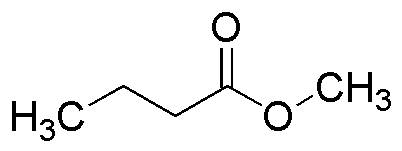Methyl butyrate is widely utilized in research focused on:
- Flavoring and Fragrance Industry: This compound is commonly used as a flavoring agent in food products and beverages, providing a fruity aroma reminiscent of apples and pineapples. Its pleasant scent makes it a popular choice in perfumes and cosmetics.
- Solvent Applications: Methyl butyrate serves as an effective solvent in various industrial processes, particularly in paints and coatings. Its ability to dissolve a wide range of substances enhances product performance and application ease.
- Chemical Synthesis: In organic chemistry, it acts as an important intermediate in the synthesis of other chemicals, including pharmaceuticals and agrochemicals, facilitating the development of new compounds.
- Biological Research: Researchers utilize methyl butyrate in studies related to cell signaling and metabolism, as it can influence cellular processes and provide insights into biological mechanisms.
- Food Preservation: Its antimicrobial properties make it useful in food preservation, helping to extend shelf life while maintaining flavor integrity, which is crucial for the food industry.
General Information
Properties
Safety and Regulations
Applications
Methyl butyrate is widely utilized in research focused on:
- Flavoring and Fragrance Industry: This compound is commonly used as a flavoring agent in food products and beverages, providing a fruity aroma reminiscent of apples and pineapples. Its pleasant scent makes it a popular choice in perfumes and cosmetics.
- Solvent Applications: Methyl butyrate serves as an effective solvent in various industrial processes, particularly in paints and coatings. Its ability to dissolve a wide range of substances enhances product performance and application ease.
- Chemical Synthesis: In organic chemistry, it acts as an important intermediate in the synthesis of other chemicals, including pharmaceuticals and agrochemicals, facilitating the development of new compounds.
- Biological Research: Researchers utilize methyl butyrate in studies related to cell signaling and metabolism, as it can influence cellular processes and provide insights into biological mechanisms.
- Food Preservation: Its antimicrobial properties make it useful in food preservation, helping to extend shelf life while maintaining flavor integrity, which is crucial for the food industry.
Documents
Safety Data Sheets (SDS)
The SDS provides comprehensive safety information on handling, storage, and disposal of the product.
Product Specification (PS)
The PS provides a comprehensive breakdown of the product’s properties, including chemical composition, physical state, purity, and storage requirements. It also details acceptable quality ranges and the product's intended applications.
Certificates of Analysis (COA)
Search for Certificates of Analysis (COA) by entering the products Lot Number. Lot and Batch Numbers can be found on a product’s label following the words ‘Lot’ or ‘Batch’.
*Catalog Number
*Lot Number
Certificates Of Origin (COO)
This COO confirms the country where the product was manufactured, and also details the materials and components used in it and whether it is derived from natural, synthetic, or other specific sources. This certificate may be required for customs, trade, and regulatory compliance.
*Catalog Number
*Lot Number
Safety Data Sheets (SDS)
The SDS provides comprehensive safety information on handling, storage, and disposal of the product.
DownloadProduct Specification (PS)
The PS provides a comprehensive breakdown of the product’s properties, including chemical composition, physical state, purity, and storage requirements. It also details acceptable quality ranges and the product's intended applications.
DownloadCertificates of Analysis (COA)
Search for Certificates of Analysis (COA) by entering the products Lot Number. Lot and Batch Numbers can be found on a product’s label following the words ‘Lot’ or ‘Batch’.
*Catalog Number
*Lot Number
Certificates Of Origin (COO)
This COO confirms the country where the product was manufactured, and also details the materials and components used in it and whether it is derived from natural, synthetic, or other specific sources. This certificate may be required for customs, trade, and regulatory compliance.

